A Brief History
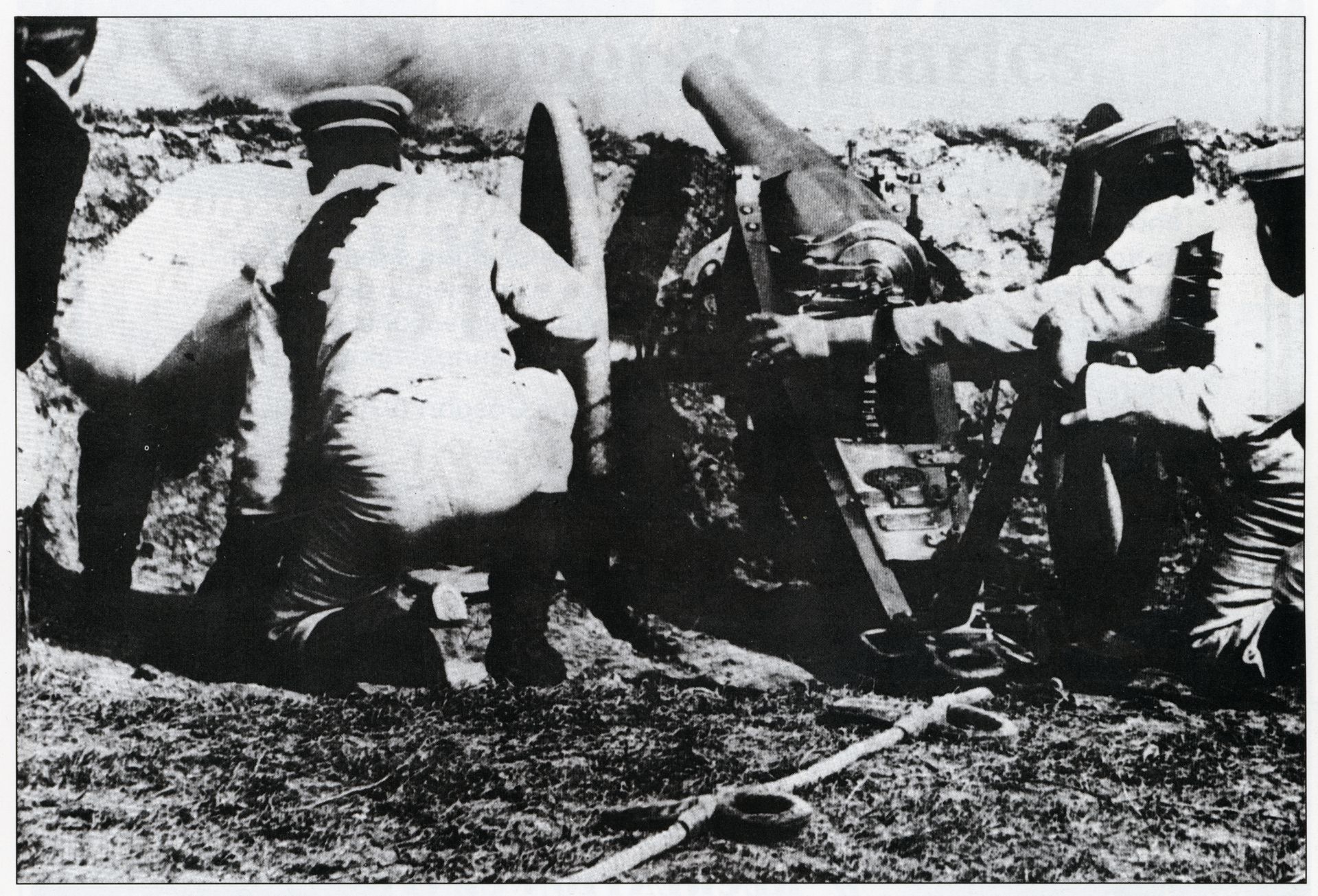
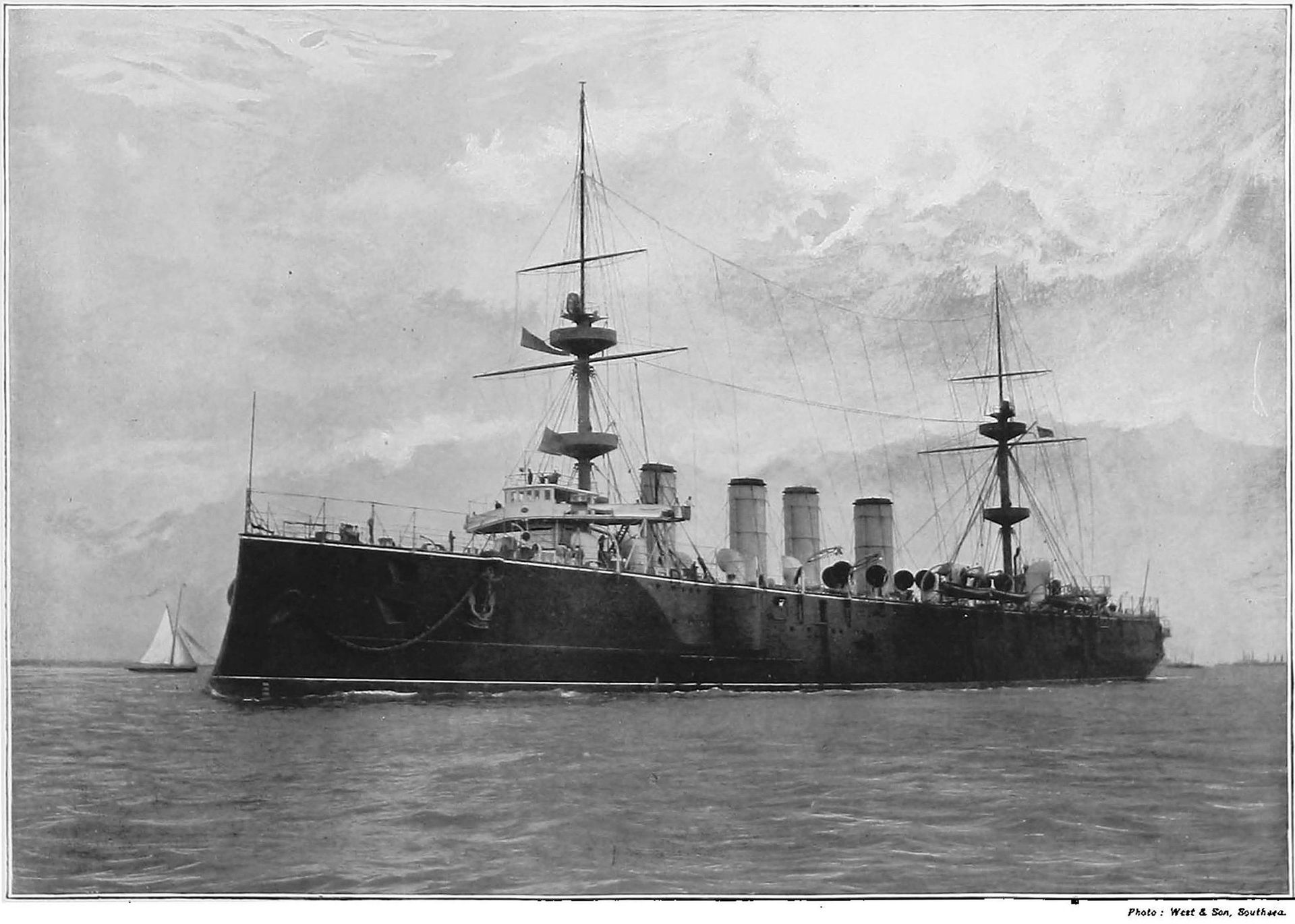
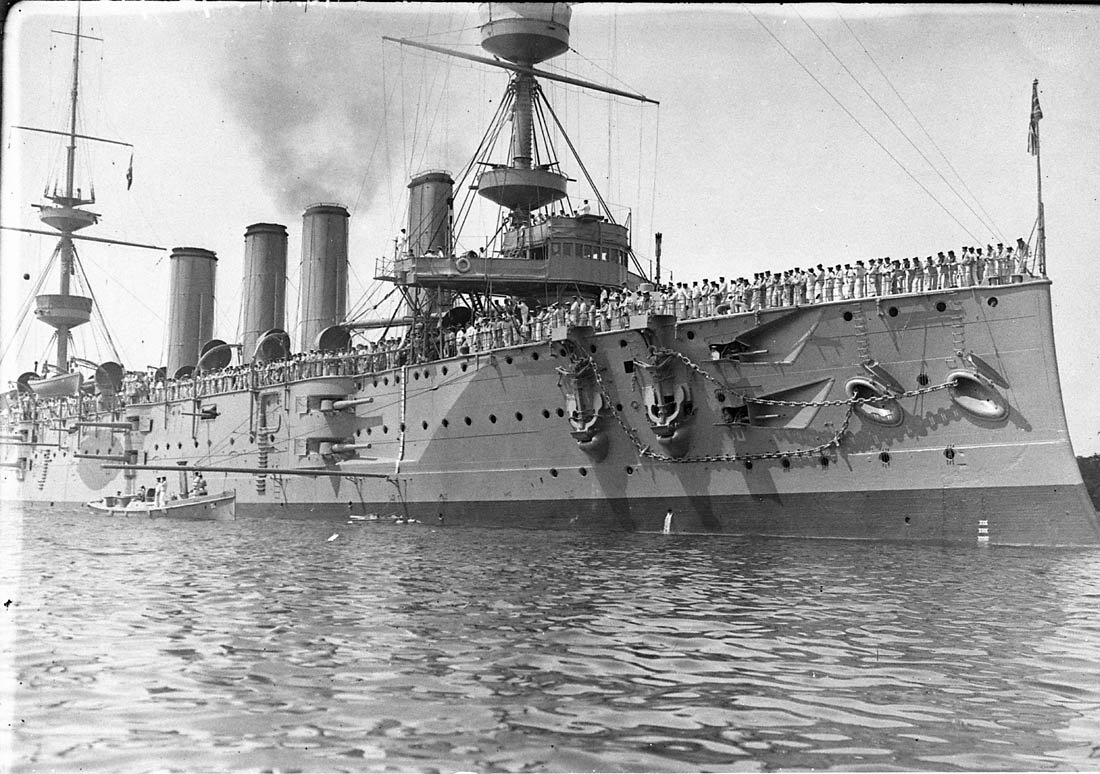
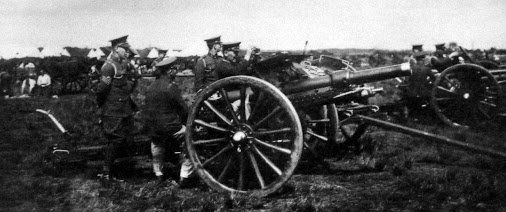
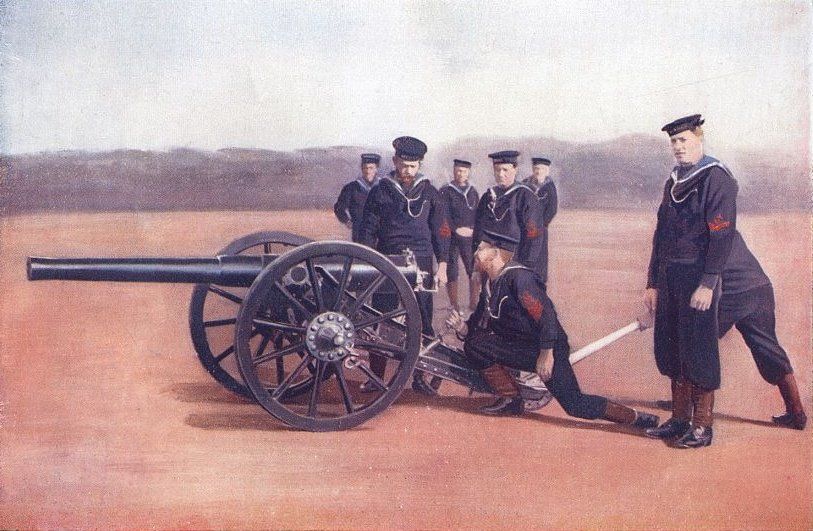

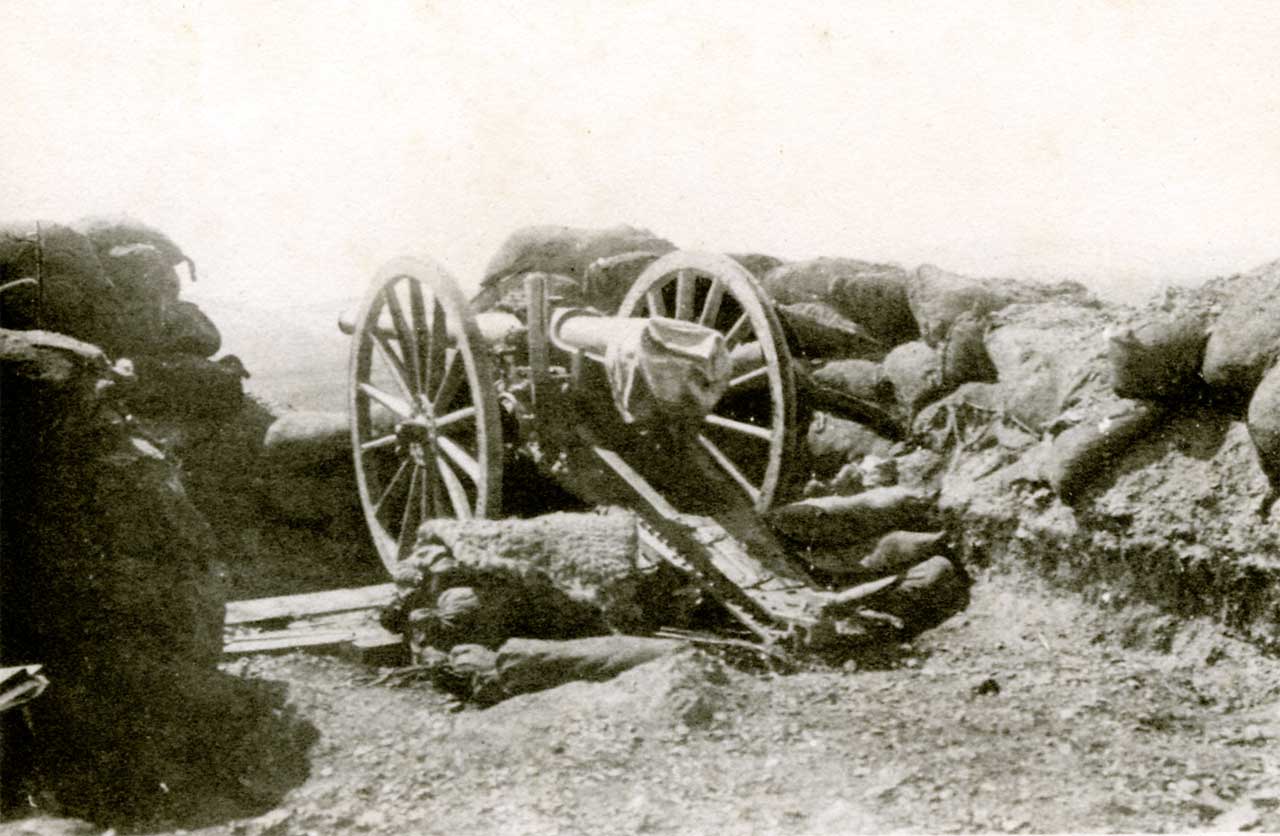
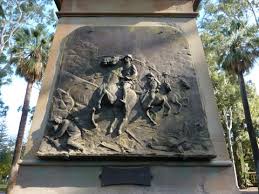
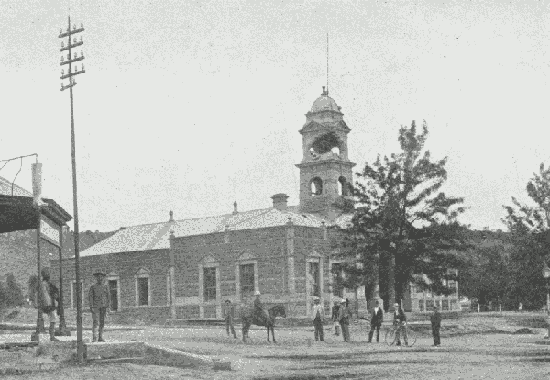

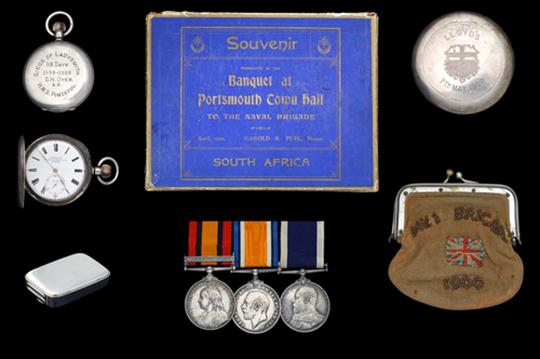
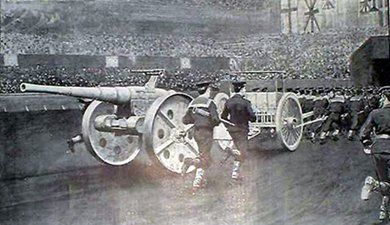

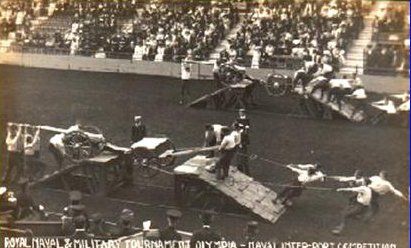
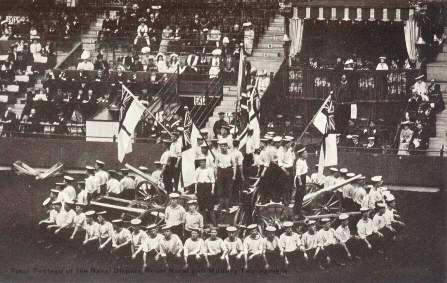
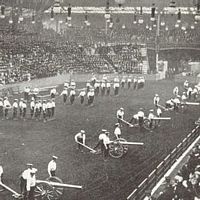
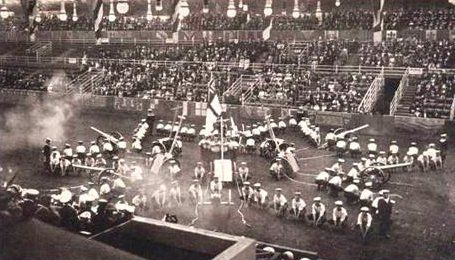
Naval Brigades
The Guns used in the Field Gun Competitions, are similar to the 12-Pounder guns used in the Boer War, and other Naval Brigade activities assisting the Army, in places such as Egypt, China and Ashanti.Naval brigades were detachments from ships consisting of seamen and Royal Marines (which were soldiers on board ships) who were landed ashore to undertake naval operations or to support the army in a wide variety of campaigns. During the period from 1850-1914, the Navy did not fight any ship-to-ship actions, and most British seamen who were on active service in operations did so as part of a Naval Brigade.
The Naval Brigades were professional organisations. Both officers and men received regular training in the techniques of land warfare at the gunnery school, HMS Excellent, at Portsmouth.
The major campaigns in which the Naval Brigades were involved:
• Burma Wars 1824-85;
• Natal and Zulu War 1879;
• Crimean War 1854-6;
• Transvaal War 1881;
• China Wars 1856-63;
• Egypt 1882;
• Indian Mutiny 1857-9;
• Sudan 1884-5;
• Maori Wars 1860-4;
• Boxer Rebellion in China of 1900;
• Kagoshima and Shimonoseki 1863-64;
• Gold Coast and Ashanti War 1873-4;
• Boer War 1899-1900.
The origin of the Field Gun competitions is linked to episodes during the Boer War,
in particular with the epic 119 day siege of Ladysmith, where the gallant defenders were helped enormously by the arrival, at the last minute of Captain the Hon Hedworth Lambton of the Naval Brigade with his 280 Blue-jackets, four 12-Pounders and two 4.7 inch guns.
The Boer Army Artillery was far superior to that of the British, and on 25th October 1899 the General Officer Commanding at Ladysmith Sir George White, the British Army Headquarters in Natal, signalled the Admiral Commanding the Cape Squadron in Simonstown to ask for assistance in the form of long range Naval Guns.
As a result, Captain Percy Scott of HMS TERRIBLE was tasked with producing plans for the mounting of two 4.7” guns for use ashore. Less than 24 hours later at 6 p.m. on the 26th October, the mountings were built and the guns dispatched together with four 12-pounders in HMS POWERFUL to Durban. From there the Naval Brigade under Captain Lambton transferred the guns to the last train to get through to Ladysmith before it was besieged for 119 days.
The Naval Brigade consisted of 750 ratings and Royal Marines and fought with distinction in several parts of the country. The guns went into action on arrival and soon silenced the Boer guns. A further number of guns were landed and transported overland by the Naval Brigade to relieve Ladysmith. During this march the guns were in action many times and, on one occasion when the wheel of one of the carriages collapsed, a 12 pounder was carried by the Blue Jackets over two miles to come into action at the top of a hill.
After the siege of Ladysmith was finally lifted on February 28th 1900 Queen Victoria sent a telegram: "Pray express to the Naval Brigade my deep appreciation of the valuable services they have rendered with their guns ".
It was Scott, then a Lieutenant, who had helped Captain Fisher (later Admiral of the Fleet and First Sea Lord) establish a Gunnery School on Whale Island at Portsmouth in the 1880s. Later as Commander Scott he was instrumental in conceiving the idea of field gun competitions, the first as early as 1900.
When the crew from HMS POWERFUL returned to this country they ran a 4.7” gun through the arena at the Agricultural Hall at Islington in the 1900 Royal Military Tournament and were greeted with wild enthusiasm by the public attending. They ran the gun through the streets of London to Waterloo Station on their return to Portsmouth.
The Brickwoods Trophy Competition sponsored by Whitbread was instituted shortly after its ‘Big Brother’, the Inter-Command Competition was first performed at Olympia in 1907.
On 28th August 1907, the Royal Marines light Infantry, from Forton, won the first
“Brickwoods Trophy” competition, and along with it this magnificent Trophy
Both competitions commemorate the feats performed by the Naval Brigades during the Boer War.
In 1896 the first ‘all-naval’ display appeared in the programme of the Tournament. This comprised of cutlass drill and gun drill by forty ratings from HMS Excellent. The programme from the 1896 Tournament states:
“The guns are brought in and, after a short march around the arena, are cleared for action and one round is fired. Both wheels are shifted. The guns are then taken round the arena at the double and advance in close order, reversing twice in close order, they then wheel into the centre and salute.”
The display was so popular that it was repeated in 1897 and subsequent years. 9-pounder and 12-pounder guns were used in the displays.
In 1900 following the relief of Ladysmith during the South African campaign, Seaman from HMS Powerful brought a 4.7 inch gun into the arena at the Tournament. On this occasion, the gun was pulled by 4 oxen who were detached from their harness before one round was fired and the sailors manhandled the gun out of the arena to great applause from the audience.
The Naval involvement in the Victorian campaigns usually involved the landing of the Blue Jackets of the Naval Brigade with their ‘portable’ field guns alongside their comrades in the Army. It seems obvious that the Naval contribution to an event organised by the Army would include their famous guns.
In 1903, a party from HMS Excellent introduced an obstacle into their display. The guns and limbers of a four-gun battery were taken over a four-foot wall in the arena at Islington. In 1905, in the centenary year of the Battle of Trafalgar the event was renamed the Royal Naval & Military Tournament. Seaman from HMS Victory (RN Barracks, Portsmouth) introduced a further obstacle in the form of a bridge, too narrow for the guns to be hauled over in the usual manner.The following year, the Tournament was relocated to Olympia in West London. The larger arena allowed the display to be scaled up. In a combined display, Seamen from HMS Excellent and HMS Victory took their guns over two walls and two bridges.
With the displays of field gun drill now a firm favourite with the audiences at the Tournament, the first competition was staged in May 1907. Two gun crews of eighteen men from the commands of Portsmouth, Devonport and Chatham took part in the first competition.
Two crews competed at each afternoon performance. The crews started at one end of the arena and began by negotiating an obstacle of planks fixed at 18-inches above the ground. The guns were reassembled before taking them over a four-foot wall. The crews continued to the end of the arena and fired one round. The course was then negotiated in the opposite direction with the winner being the first crew to cross the original start line. The winning crew was awarded one point; the crew with the most points over the period of the Tournament was awarded a trophy. The winning crew in 1907 was HMS Cambridge, the gunnery school in Plymouth.
The course was changed in 1908 with a ‘chasm’ replacing the plank obstacle. The original chasm was formed by placing two ramps opposite each other at a distance of 7ft 6in apart. This was considered to be an ‘easy jump for an ordinary man’. Crews were not permitted to use any additional equipment to assist in transporting the gun and limber across the chasm.
In 1912 the organisers removed the chasm from the competition in favour of a single ramp which was negotiated on both the outward and homeward legs of the course. The chasm returned in 1913 and was extended to a distance of 30ft. Crews were permitted to use wires, ropes, spars etc to traverse the obstacle. In addition two five-foot walls were rigged at the ends of the arena. Although the chasm was reduced to 28ft the competition remained fundamentally the same throughout the interwar years. Aggregate Time and Fastest Time Cups were introduced in 1924.
Following the Second World War, the first post war Tournament was held in 1947 at Olympia with the addition of a crew representing the Fleet Air Arm. The Royal Tournament relocated for the final time in 1950 when it moved to the larger venue of Earls Court. Crews from Portsmouth, Devonport, Chatham and Fleet Air Arm competed at ‘The Court’ until 1960 when the Chatham Crew withdrew from the competition.
The remaining three crews participated until the final Royal Tournament 1999.
Inter Command Field Gun Competition - History
By Richard Thompson (aka Thommo-the-Phot)
This article was first published in a Field Gunners Association Newsletter 2006
From information I have gathered using my collection of “Royal Tournament” Programmes, the following years are quite relevant to the History of the Inter-Port Field Gun Competition.
Up until and including 1905, the “Royal Naval and Military Tournament” was held at the Agricultural Hall, Islington.
The main Naval involvement for several years had been from 40 ratings drawn from HMS Excellent, carrying out Cutlass Drill, and a Gun Drill Display, comprising as follows:
“The Guns are brought in and, after a short march round the arena, are cleared for action and one round is fired. Both Gun Wheels are shifted. The Guns are then taken round the arena at the double and advance in close order, reversing twice whilst in close order, they then wheel into the centre and Salute.”
Gradually the display was annually improved upon, using 9-pounder and 12-pounder Guns (the same guns that are used in both the “Command” and “Brickwoods” competitions!).
The following is the chronological evolvement of the competition, as we came to know and love it:
1900 - 4.7” Guns were hauled into the arena by four span of Oxen and Sailors, the animals were then “out-spanned as though out to graze”, the Sailors fired one round, and then manhandled the Guns out of the arena.
1903 - additional to the display around the arena, the seamen from HMS Excellent introduced an obstacle in the shape of a 4’ Wall over which the guns and limbers of a four-gun battery were taken.
1905 - the seamen of HMS Victory (R N Barracks) added a further obstacle in the form of a bridge, too narrow for the guns to be hauled over in a ‘normal’ manner.
1906 - on the 17th May, the Royal Naval and Military Tournament moved to and opened at Olympia, and the men from both establishments (Excellent and Victory), in a combined display, took the guns over no less than two walls and two bridges.
1907 - the first competition was held, two crews of eighteen, coming from Portsmouth, Devonport and Chatham, competed at each afternoon performance (a display similar to the original was put on for each evening performance), as follows:
“Starting from one end of the arena, the teams first negotiated an obstacle of planks fixed 18-inches from the ground. Then, having reassembled the guns, they crossed a 4-foot wall and on arrival at the other end of the arena fired one round. The race was continued on the return journey, the team first crossing the original starting line being awarded one point; the team which secured the biggest number of points throughout the run of the Tournament winning the Trophy.”
1908 - the Inter-Port Competition was livened up by the substituting the plank obstacle with a “Chasm”. The two ‘Ramps’ were placed 7’ 6” apart, and the men had to pass the gun and limber over the chasm without the use of any other appliances!
1909 - Inter-Command Challenge Cup was first awarded.
1912 - the chasm was replaced by a single ramp, for both the outward and homeward journeys.
1913 - the two ramps returned, with their gap lengthening to 30-feet, with both men and guns being required to cross the chasm by means of sheer-legs and a wire jackstay. With a 5-foot wall at either end of the arena, the course and conditions remained virtually the same until the end of the competition in 1999. Spot the difference for the Wheel Numbers, though! At the evening performances, “The Royal Navy Field Battery Display” was carried out as follows:
“The display consists of various movements carried out by a Naval Battery of six 12-pounder 8cwt. Field Guns.
1. The Entry and Salute.
2. Battery in action, facing Royal Box.
3. Guns dismounted and remounted.
4. Gun and Limber wheels exchanged.
(The procedure adopted in the event of damage to the gun wheels).
5. Gridiron March and Half-Batteries brought into action.
6. Dismount and retire with gear.
(The method of abandoning guns during a temporary retirement, leaving them useless to an enemy).
7. Marching with disabled Gun Carriage.
8. Gridiron March.
9. Remount.
10. Tableau. Star.
11. March Past at the double.
12. Reverse at close intervals.
13. March Past and Salute.”
1915 to 1918 - 1st World War, therefore no Tournament, which recommenced in 1919
The Evening performance saw the choreographed display replaced by more competition runs sometime before 1928, possibly when the two other trophies were introduced.
1924 - The Aggregate Time Challenge Cup, and the Fastest Time Cup were introduced.
1925 - Individual “Silver Medals” were introduced - initial winners being HMS Excellent.
1927 - first time one crew were awarded all three trophies (HMS Vivid, Devonport).
1936 - No Competition at the Royal Tournament (reason why at the moment remains unclear!)
1940 to 1946 - 2nd World War, therefore no Tournament, which recommenced in 1947.
1947 - Naval Air Command replaced the Royal Marines in the competition (12 runs for each Crew)
1949 & 1950 - Final year at Olympia, followed by the first year at Earls Court
1952 - Bronze medals introduced for the runners up Crews
1960 - Chathams final year in competition
1961 - Competition runs upped to 16 for each Crew
1962 - 3 minute barrier broken (by FAA - 2 mins 54 secs)
1965 - Copenhagen Cup first competed for (having been presented at the British Trade Fair, Copenhagen the previous year)
1977 - Least Penalties Cup introduced - initially sponsored by Plymouth Gin
1993 - Royal Tournament cut from 3 to 2 weeks, hence
Competition reduced to 14 runs per Crew
1999 - THE END (Sadly!!!)
Pompey’s post War Clean Sweeps (of the 3 major trophies!)
- 1948 - 1957 - 1970 - 1975 - 1981 - 1984 - 1986 - 1987 - 1997 -
I have managed to gather the above information from a number of sources,
however, if you know any of it is incorrect, please let me know, and I'll rectify it!
Bibliography:
Royal Tournament Programme Collection - Richard Thompson
The Story of the Royal Tournament - Lt. Col. P. L. Binns
GUNS AND GUTS - Richard A. Wilson
The Brickwoods Trophy - Whitbread Historian
100 Years of Field Gun
Every year for two weeks in July during the Royal Tournament at Earls Court, London, the Royal Navy’s Inter-Port Field Gun Competition takes place. For the sailors who take part in the competition it as near to war as you can get and is the culmination of six months of dedication, fitness, courage, teamwork and,
Back to Top
above all, discipline.
Audiences are held spellbound as the three commands from Portsmouth, Devonport and Fleet Air Arm do battle in a twice daily race that see two teams of 18 men take a gun and limber that dates back to the last century and weighing over a ton, plus associated equipment over a five foot wall, across a twenty-eight foot wide chasm, through a four foot high by two foot wide hole and bring the equipment into action, to engage the enemy and fire three rounds. In a rearguard action enroute they have to overcome the same obstacles. This is called: Out, Back and Home. Each section is timed to the nearest one-hundredth of a second and at the end of the three sections the times are totalled. However, the run is still not over, penalties can still be incurred if the drill is not carried out correctly, for instance: a man moving before the ‘G’ is sounded on the bugle or throwing or dropping a piece of equipment into the chasm. These penalties are turned into seconds and these are added onto the final time. The crews are awarded 2 points for a win, 1 and a half for a tie, 1 for a defeat, and 0 for a disqualification or a run taking over 4 minutes to complete.
At the end of the two weeks ‘field gunning’, four trophies are awarded. The Inter-Command Challenge Cup is awarded to the crew gaining the highest number of points over the fortnight, and this record is held by Fleet Air Arm for gaining the maximum 32 points in 1966 and the trophy is now held by Devonport for gaining 29 points. The Aggregate Time Challenge Cup is awarded to the crew who has the lowest aggregate official time over the 16 competition runs; the record is held by Devonport at 39 minutes 20.34 and the trophy is now held by Devonport. The Fastest Time Cup is awarded to the crew who achieves the fastest out, back and home in one run. Before 1999 this record was held by Portsmouth and had stood for 15 years. This year Devonport broke the world record when they recorded a near faultless run of 2 minutes 40.43. The Sunday Express Plate, which in the past has been called various other names, is awarded to the crew that incurs the least number of penalty points over the competition. Fleet Air Arm won the trophy this year and they hold the record of 2 penalty points.
Throughout the competition the results are signalled to the fleet worldwide where the men follow their crew’s progress with the same fanatical interest, as they would show in their football team of their choice. Many ex-gunners, or simply a keen supporter of the gun race, will make an annual pilgrimage to Earls Court,
some staying for the two weeks
duration, just to share an atmosphere that can not be found anywhere else in the world. However, this event would never have even started if it were not for a historic event, which happened 100 years ago:
The Relief of Ladysmith.
The display in its present competition form was started in 1907,
inspired by the exploits of a Naval Brigade during the Boer War in 1899.
In South Africa at the turn of the last century relations between the Dutch in the Transvaal, the Orange State, the British in the Cape and Natal deteriorated rapidly after a conference held in Bloomfontein, capital of the Orange Free State, to resolve the problems arising form the massive influx of immigration as a result of the discovery of gold in the Transvaal and their claims for citizenship rights ended in stalemate. Both sides moved forces to their mutual borders, the British forces in Natal numbered less than 16,000 whilst the Transvaal Burgher army alone totalled nearly 27,000. In September the decision to despatch more than 10,000 troops to South Africa from home and abroad was made in London. The Transvaal Government responded to this major troop movement with an ultimatum issued on the 9th October, with a time limit of two days, that all British forces were to withdraw from the borders of the Transvaal and all the troops which had landed since the previous June were to be moved from South Africa and those on their way from overseas were not to be landed. Two days later on the 11th October 1899 at 5pm war was declared and the Boers invaded.
The British forces were quickly overwhelmed and forced back to the towns of Mafeking, Kimberley and Ladysmith, which were then besieged. Ladysmith was the most vulnerable of the three towns
and should it fall a great moral victory could be claimed by the marauding Boer forces.
It was at this point that the Royal Navy was called into action.
At anchor off Capetown were the cruisers, HMS Terrible and HMS Powerful, the British Commander in Natal, General Sir George White VC, signalled the ships for assistance, particularly long range guns. Fortunately for the General, Captain P. Scott RN of HMS Terrible was a gunnery expert and he quickly designed a carriage that could hold 6 inch, and 4.7 inch, 12 pounder naval guns for transit and in action. Following initial tests, all the necessary guns and equipment were transported to Durban by HMS Terrible; the carriages were then speedily manufactured in the Durban Railway workshops. The contingent was soon ready and under the command of Captain H. Lambton RN, the 280 officers and men with two, 4.7 inch guns, four long range 12 pounders and four maxim guns the Naval Brigade as they were now called, left Durban by rail for Ladysmith. Their train was the last to complete the journey to Ladysmith on the 30th October just as the siege and bombardment started.
The Naval Brigade were soon in action against the Boer artillery; their long range guns were so effective in countering the enemy batteries and holding them at bay that it was not long before Captain Scott was being asked to provide another brigade. This was duly done and the new brigade acted in support of General Buller’s push towards their besieged comrades. Due to the nature of this operation the railway was of little use, therefore the guns had to be manhandled over difficult terrain to be brought into action in many different engagements, eventually reaching Ladysmith after 120 days of blockade. This is the whole idea of Field Gun: to try and reconstruct as near to the truth as possible what happened a century ago during the relief of Ladysmith. The men not only had to cope with very difficult terrain but they had to construct some sort of way of getting across a bottomless area of land; this is where the present days chasm idea came from.
The news of the relief of Ladysmith was greeted with great jubilation in Britain and Queen Victoria sent a telegram to the Naval Brigades thanking them for their invaluable assistance.
Leaving Ladysmith on the 7th March 1900 the sailors of Powerful and Terrible were soon back on board,
the Powerful heading for home and arriving in Portsmouth on the 11th April.
The officers and men of Powerful were soon invited to a number of military and civic receptions culminating in a Royal audience with Queen Victoria where she personally thanked
the ship’s company for their part in the saving of Ladysmith.
The Royal Military Tournament of 1900 was held in Islington Agricultural Hall and featured men from HMS Powerful parading one of their 4.7-inch naval guns called ‘Joe Chamberlain’. This proved most popular and the Navy’s contribution continued as part of the Tournament, which moved to Olympia in 1906.
Since that year it has become customary to say that the Inter-port Field Gun Competition at the Royal Tournament is in commemoration of what Lambton’s men of the Powerful achieved in saving the town of Ladysmith. But each one of all the Naval Brigades ashore in South Africa during the second Boer War performed deeds that are worthy, each in its way, of such salutation.
In 1907 a competition replaced the parade for the first time, the three depots of Portsmouth, Chatham and Devonport providing the gun teams. This was the idea of Commander P.H Hall-Thompson RN, who is regarded as the father of the field gun competition. The 1914-1918 war stopped all such events for its duration but the competition returned with the new Royal Tournament of peacetime. The Second World War ‘stopped play’ for a second time, but the resumption saw two important changes: the venue was Earls Court in1950 and by now the Royal Tournament’s Field Gun Competition had been joined by a team from the Fleet Air Arm. Upon their entry the newcomers won the Aggregate Time Challenge Cup as well as the Fastest Time Cup.
In 1960 Chatham ran at the tournament for the last time.
Throughout the history of the Inter-Port competition as many as
eight crews have competed including the Royal Marines in the 1920’s.
However it is not just this year that records have been set and then broken.
In 1981 Portsmouth produced a record run of 2 minutes 42.4, only to see it snatched away again two years later by Devonport with a run of 2 minutes 41.1. However, the very next year, 1984, Chief Petty Officer PTI Keith Mack trained a Portsmouth crew, which put in a blistering run of 2 minutes 40.6, which was the record that had stood for fifteen years. But it is not all glory and record breaking as was proved in 1982. A.B Allen the Flying Angel (no.7) for Portsmouth was the last man being pulled across the chasm on the run back. He reached the home ramp and released the ten-foot spar he was carrying as his drill required and ran on down the ramp. However, instead of checking on the collapsing sheer legs and passing on the outside of them he went through the middle. The collapsing sheer legs killed him. (The sheer legs weigh 170lbs) Broken bones, pulled muscles and severe cuts were the risks that dedicated gunners accepted and before they signed up they were required to sign a disclaimer stating that they would not sue the Navy for damages. But when they signed the disclaimer they never expected a man would be killed in the toughest team sport in the world.
Sadly, due to ‘Government cuts’ this year was the last year of the Royal Tournament as everybody knows it and the final time anyone will ever ‘run the gun’. On 20th July 1999 the Government confirmed what many people had been dreading for months, the fact that the field gun competition would come to an end in August 1999. Both at Devonport base, HMS Drake and at Earls Court there was a very subdued atmosphere. On the night of Devonport’s last ever run the ‘A’ Crew stayed in their mess for most of the day and when the moment came they all had tears in their eyes. There were mixed emotions and a tense atmosphere as the crew came into the bar. Nobody knew what to say whether to congratulate them or to give them sympathy. Some members of the crew just sat and stared at their lynch pins, crying. They were inconsolable. The last night was also a moment I’ll never forget. It ended in controversy as all three crews wore black armbands during the run, even after they were told by the MOD not to, but whatever anybody did it would not change the future. When Devonport went into the arena to collect their trophies there was not a dry eye in the arena. When the commentator announced it was to be the last time we would ever see the ‘Men of Field Gun’, the whole arena showed their anger by stamping the floor or banging their chairs. It was obvious that no one wanted it to end, however, it was too late. Backstage the Devonport crew should have been celebrating their New World Record and their overall success but they felt as if there was no celebrating to be done.
The two weeks of blood, sweat and tears were starting to take their toll and the crew of ’99 just wanted to forget about the future without field gun and try to remember all the good times they had at Devonport, Portsmouth and the Fleet Air Arm.
It might have been the toughest team sport in the world but it was not good enough for the Government of today. Sadly all things have to come to an end at some time. Unfortunately in the memories of all field gunners and supporters 1999 proved to be one of the saddest years of their lives.
This is why it will always remain in the bodies and souls of all field gunners
and supporters the ultimate team sport.
Thank you to the Oggies for this article...
